I received the Rofis TR18 from Rofis for the review
The TR18 is another flashlight from Rofis that features a rotating head, transforming from a linear to a 90° flashlight. The TR18 is powered by an 18650 or 2 CR123 batteries.
The TR18 comes in this box
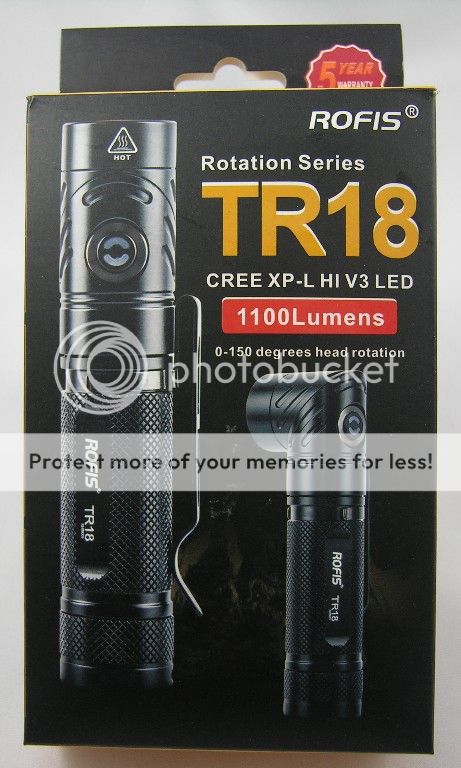
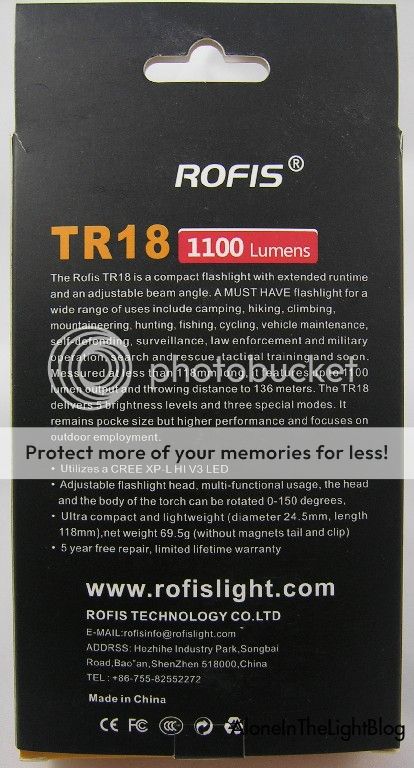
Inside the box: The TR18 with the clip, a sheath, lanyard, spare o-rings, magnetic tailcap accessory, manual, warranty card.
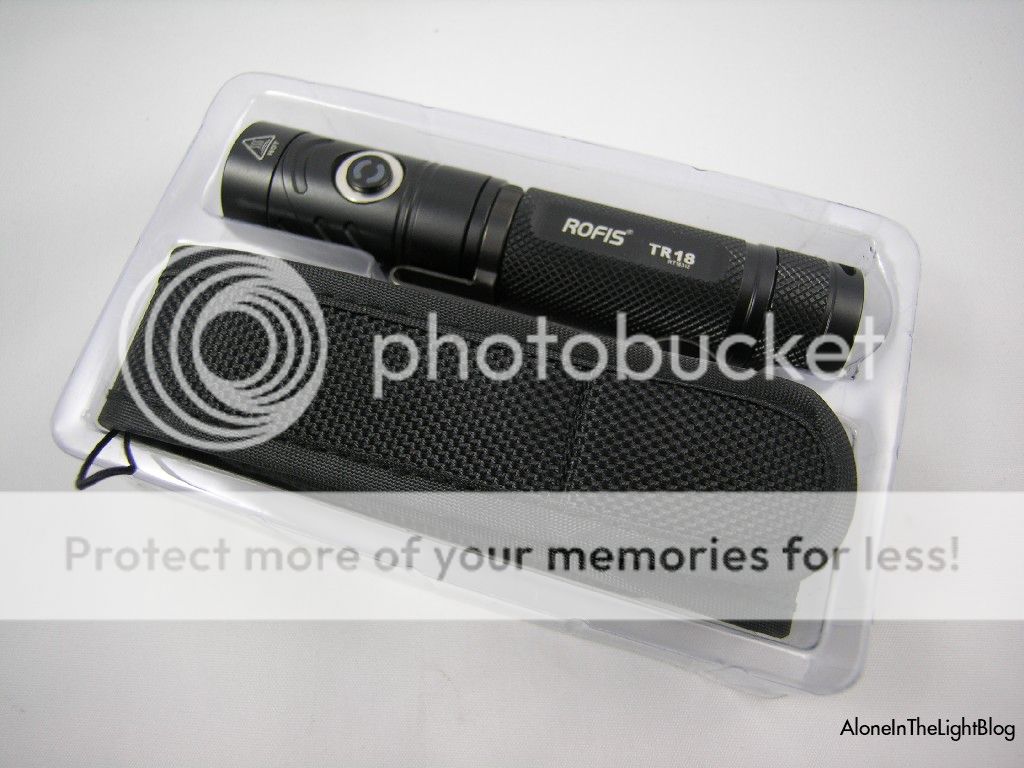
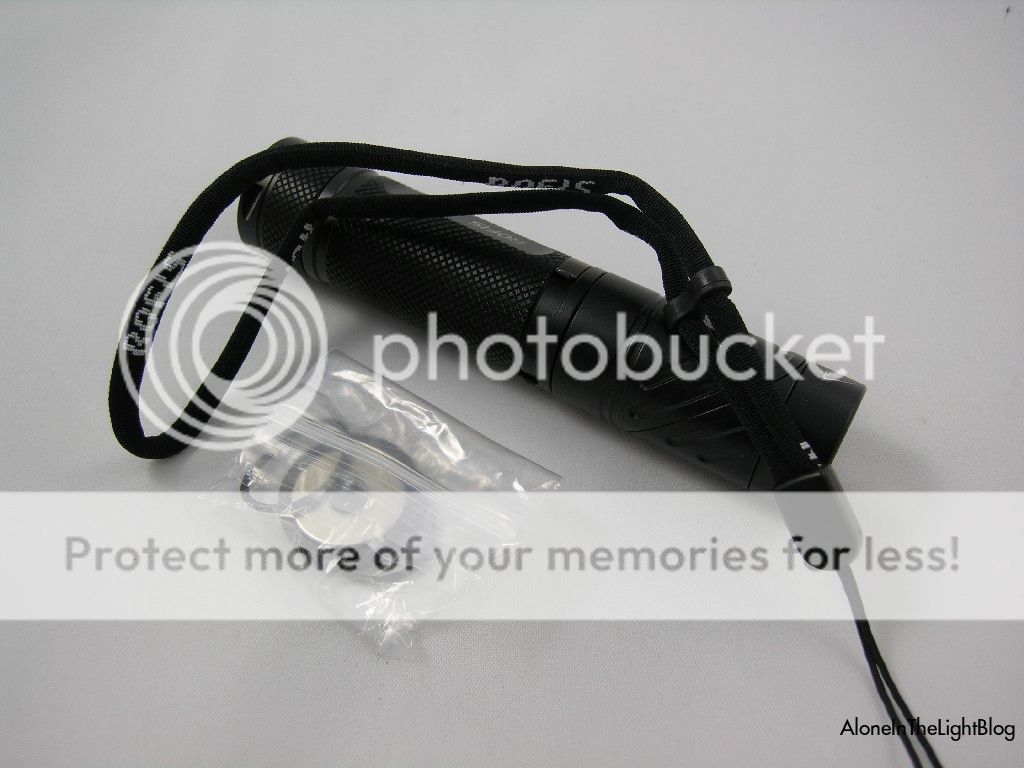
The TR18
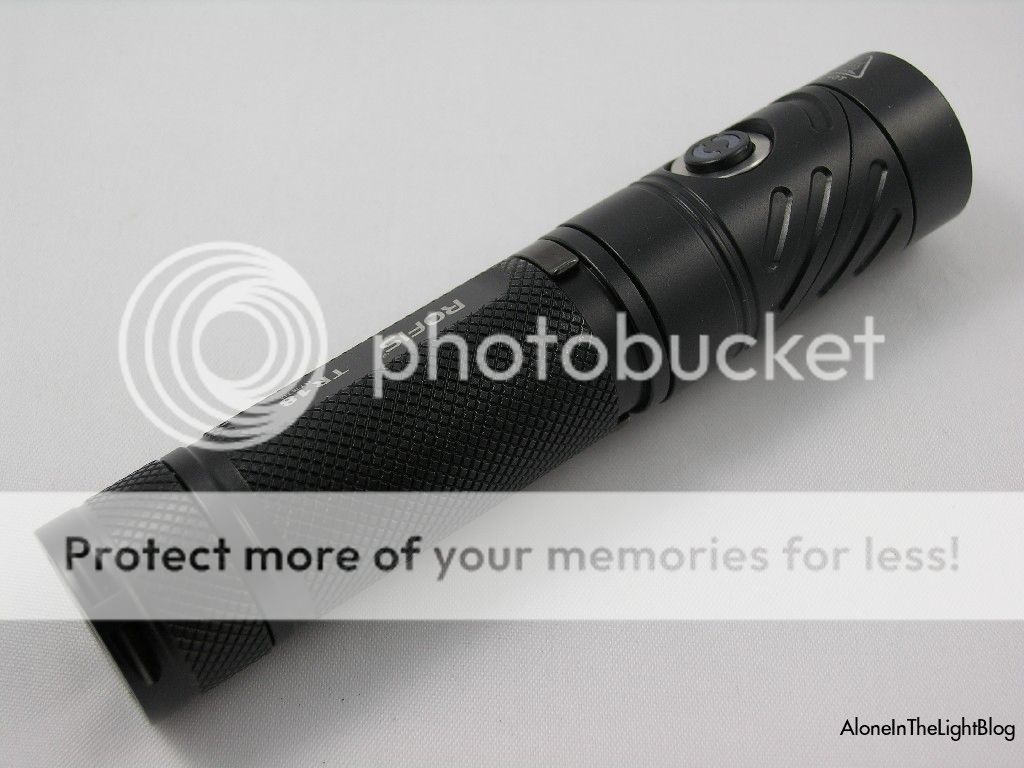
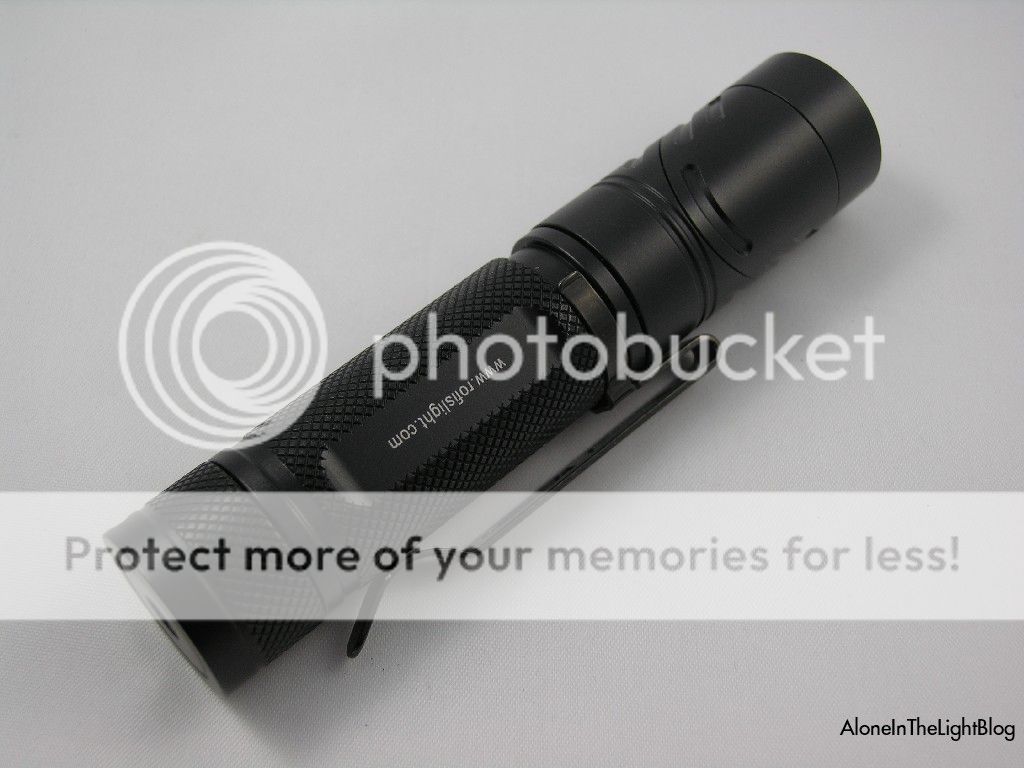
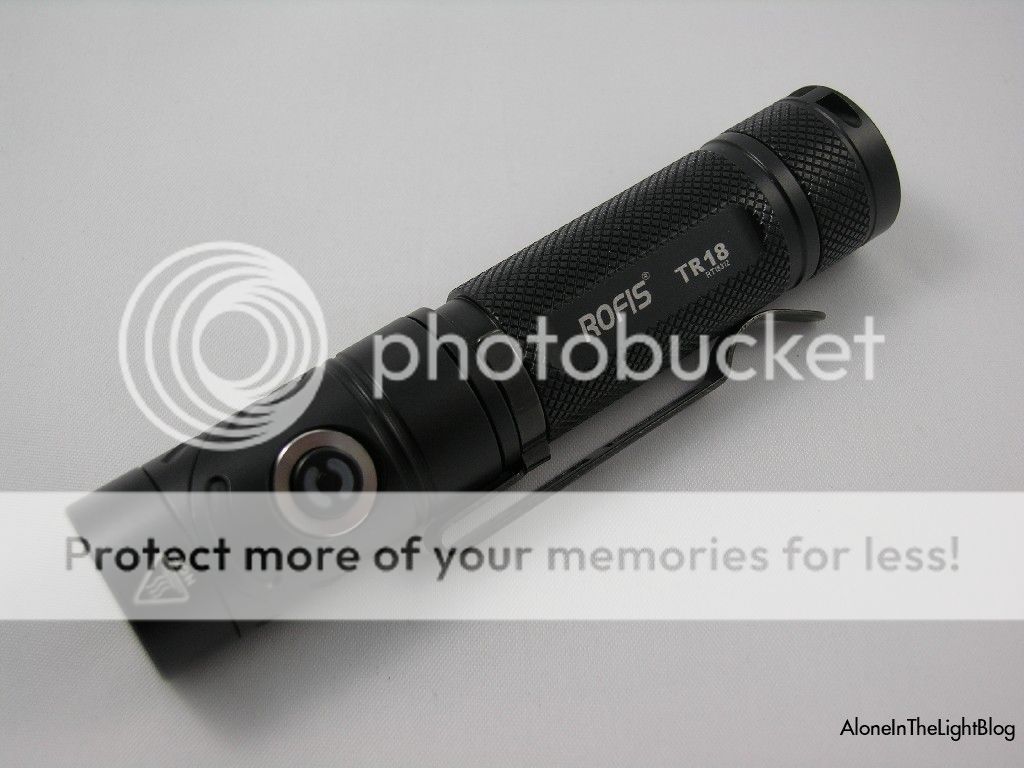
Rofis rotating head system, on the TR18 works very smoothly and requires way less force than the one on the TR20
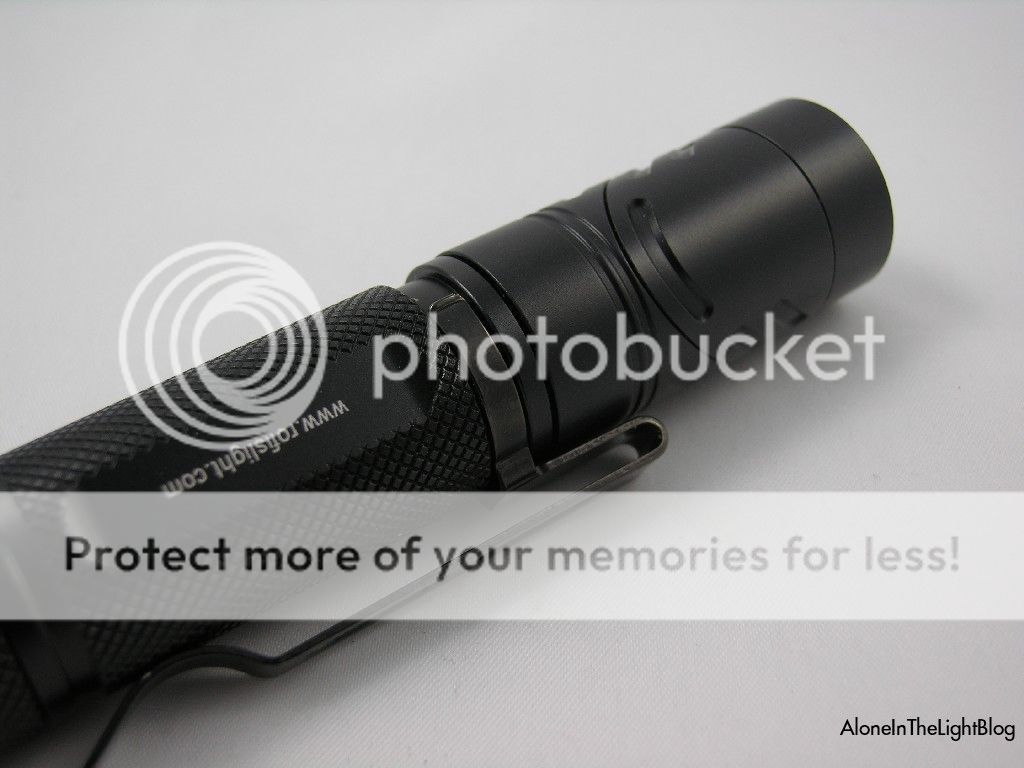
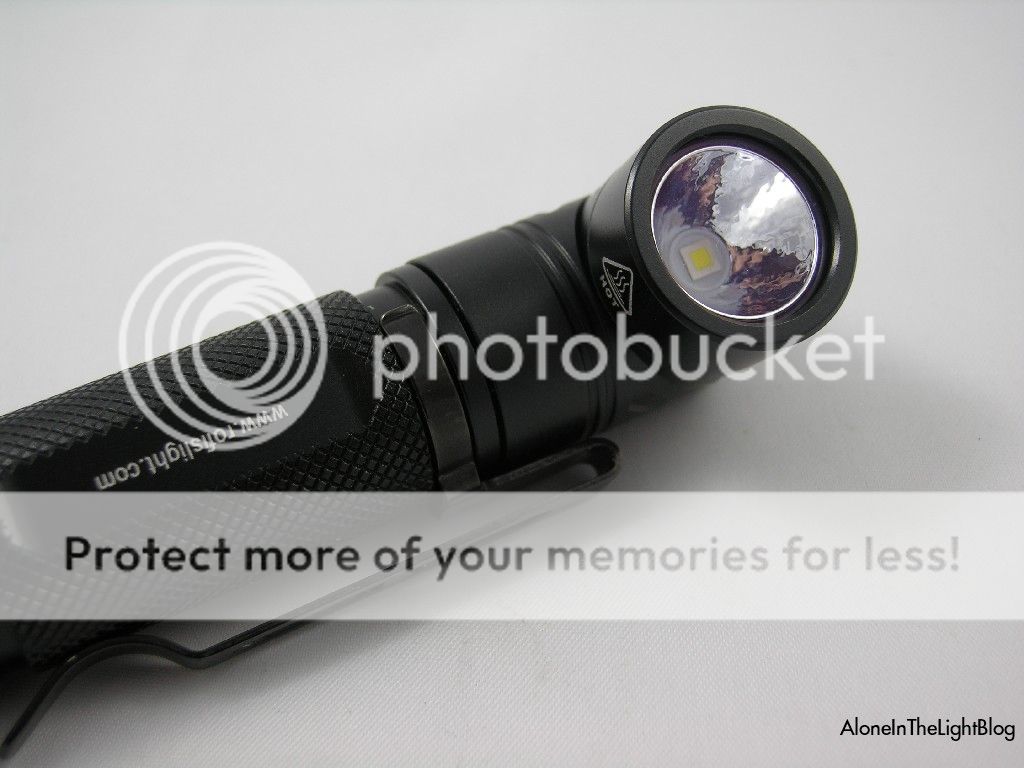
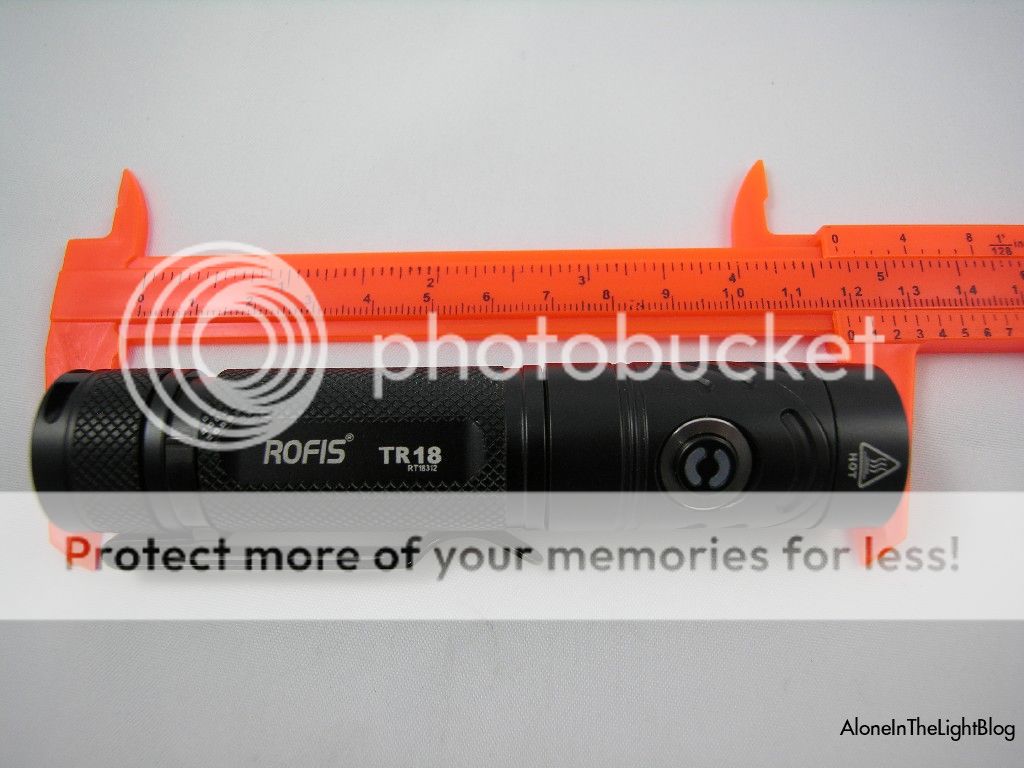
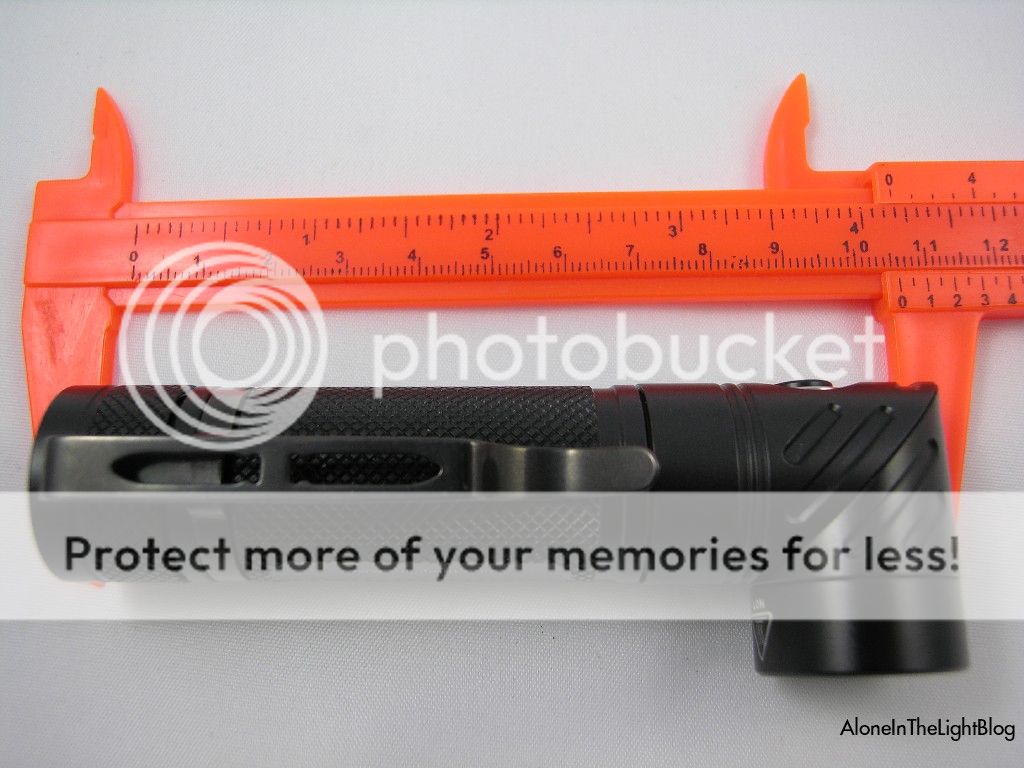
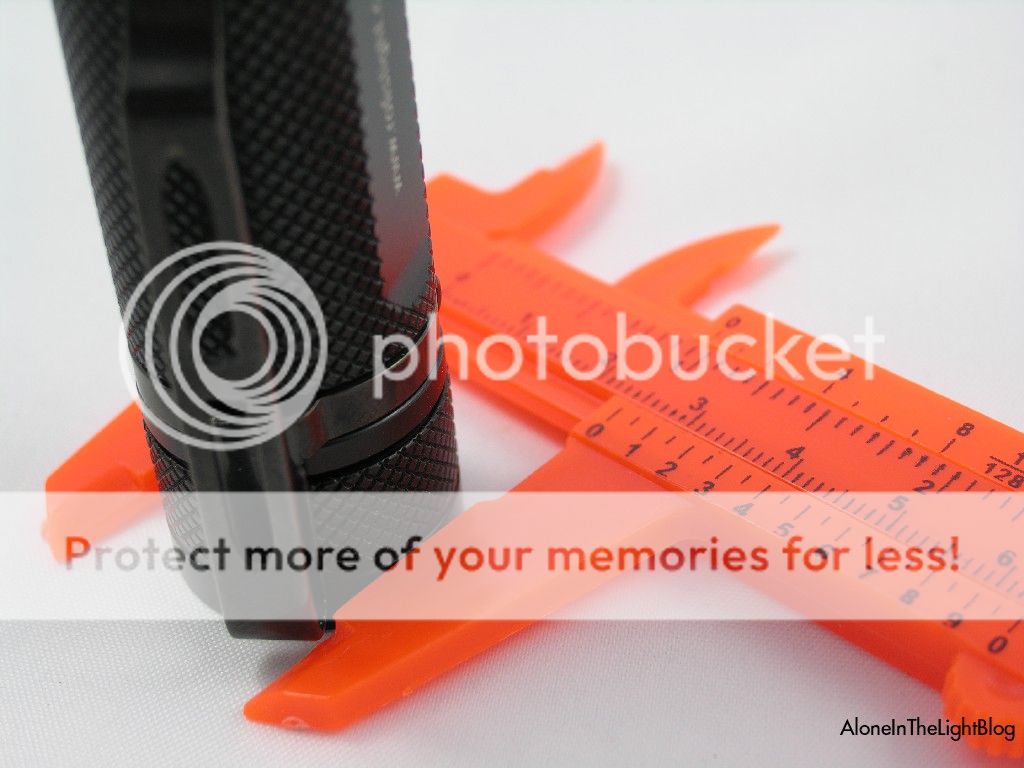
Inside the head there's a XP-L Hi emitter, in a light orange peeling reflector, under a glass with AR treatment.
There's an electronic switch at the head, accessible in both configurations
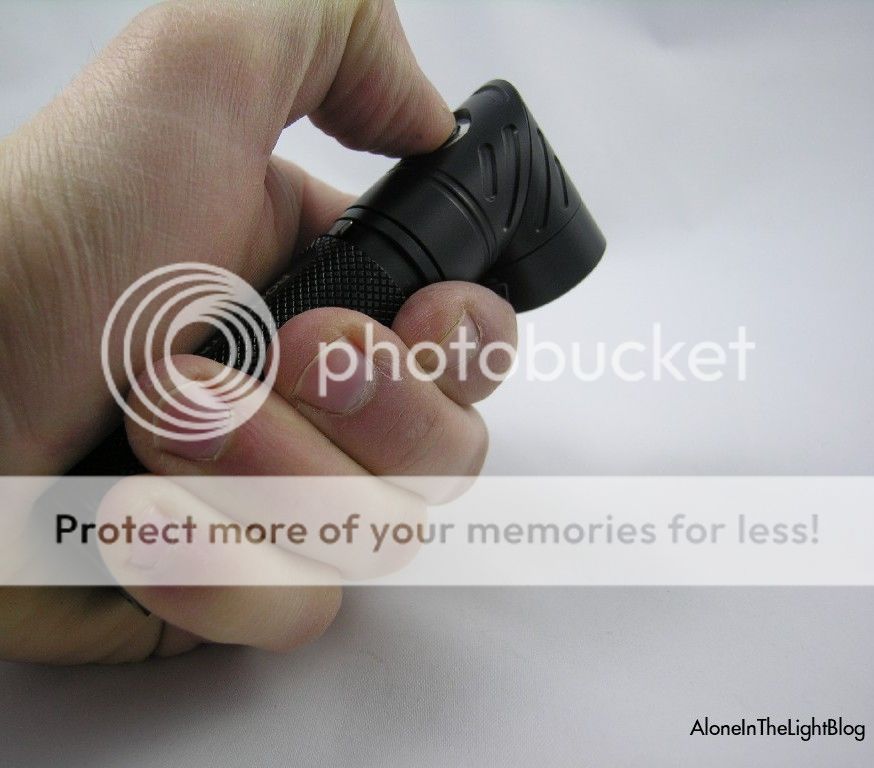
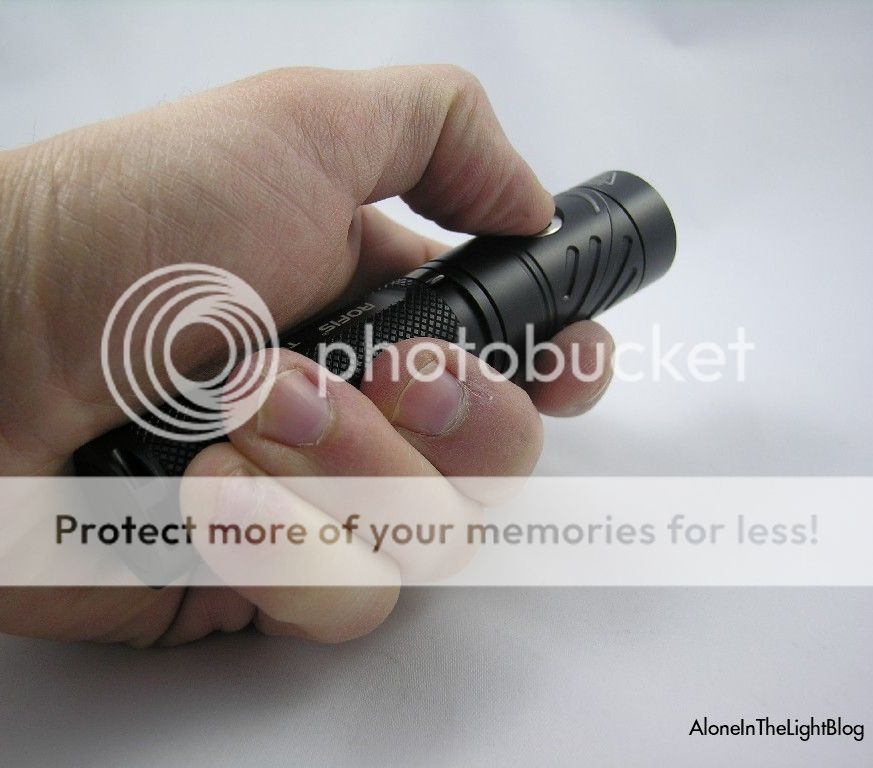
It has a LED underneath it
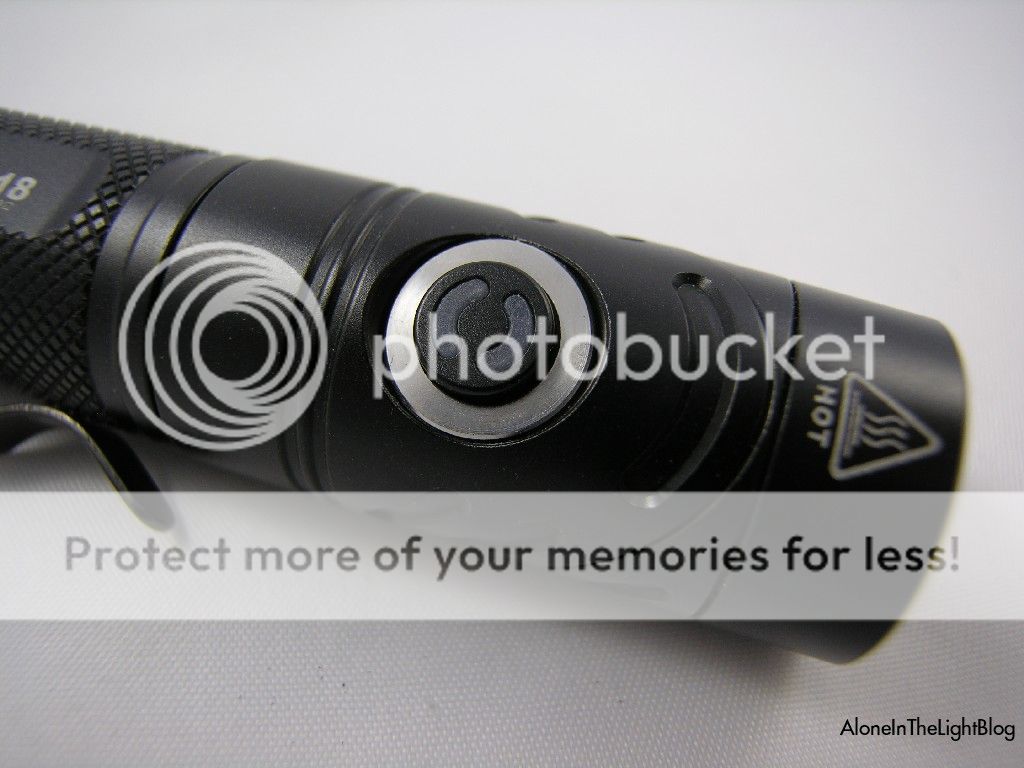
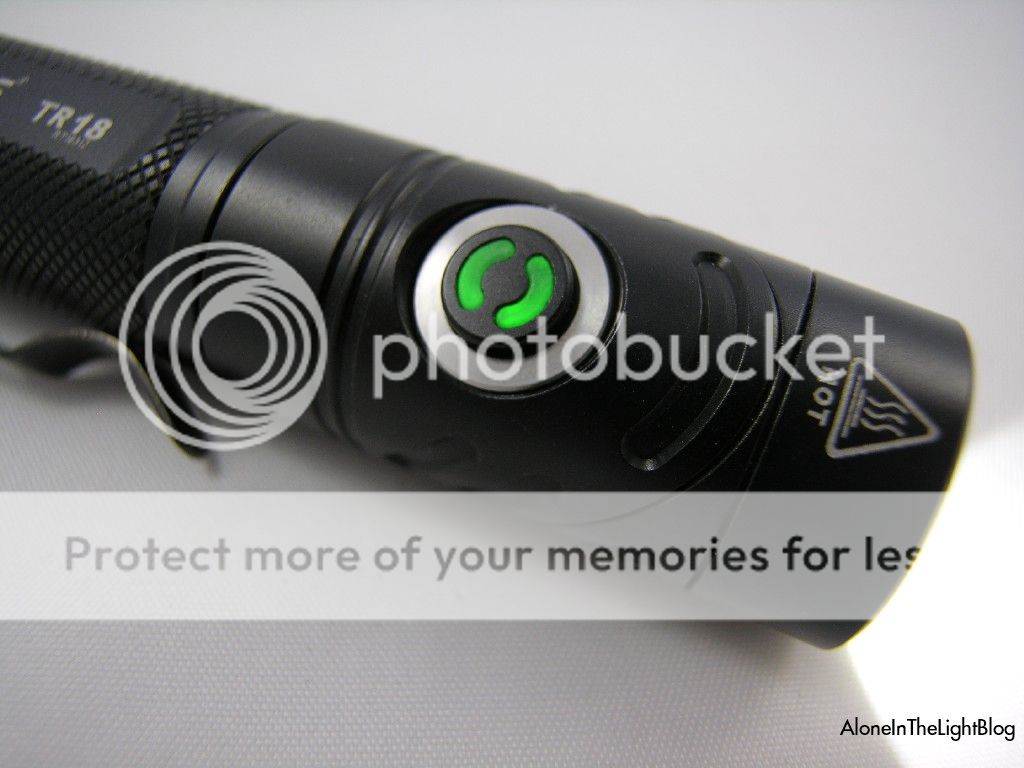
The clip is long and with good tension.
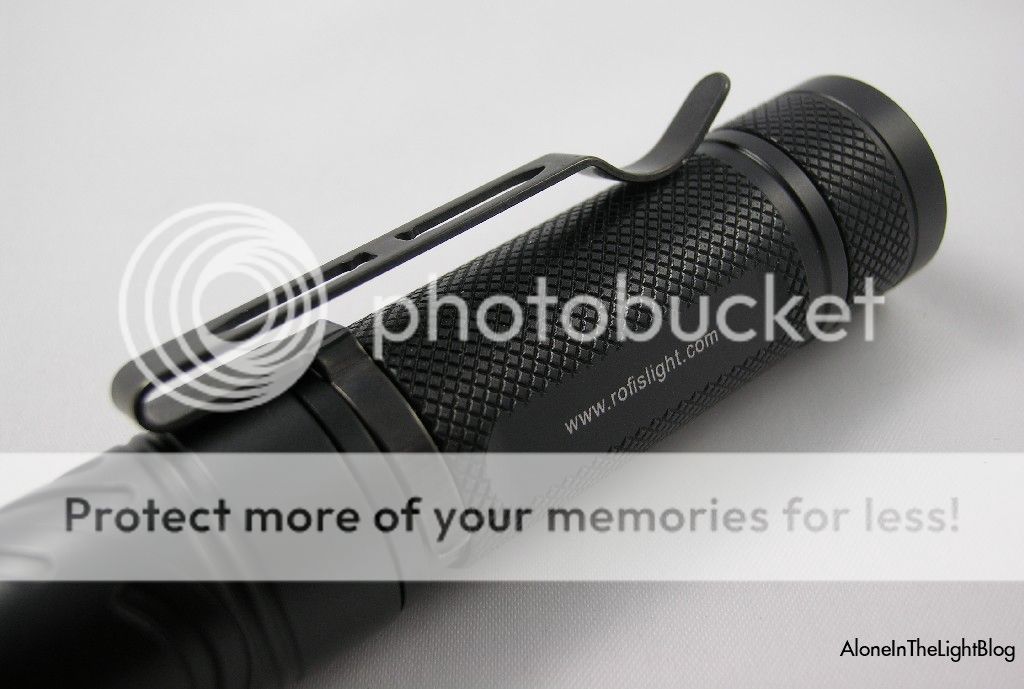
As in the TR20, the clip is not reversible, but the body is.
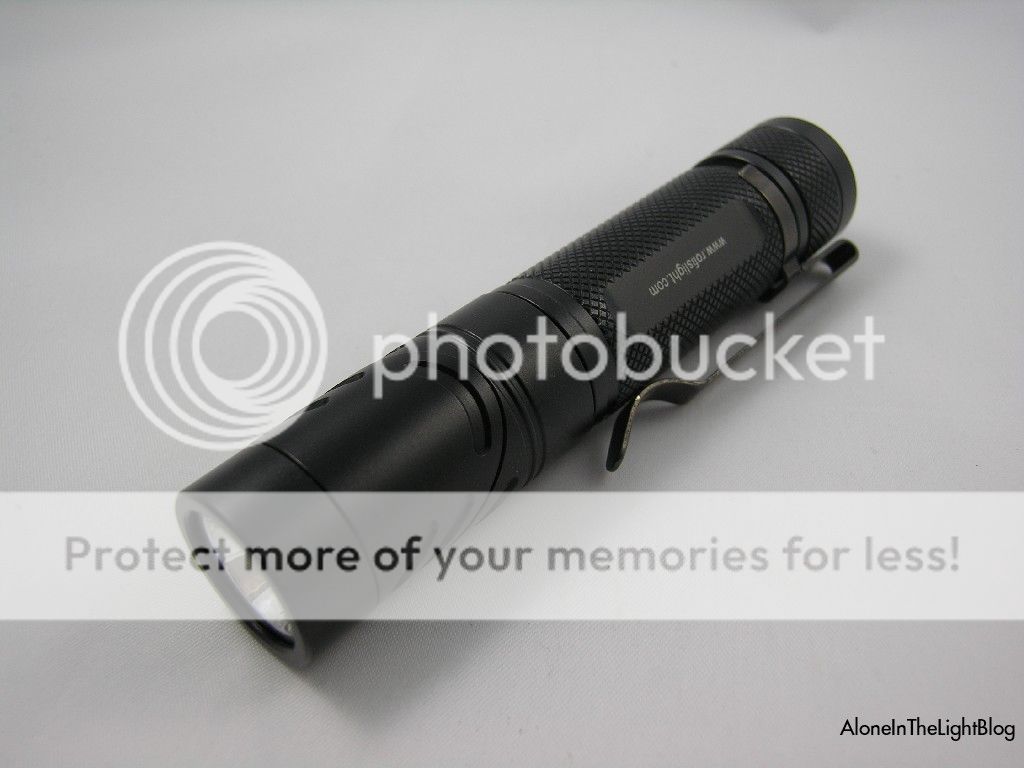
The tailcap is flat with tripod threads. In the accessories there is a magnetic tailcap attachment that can be connected screwing it in place
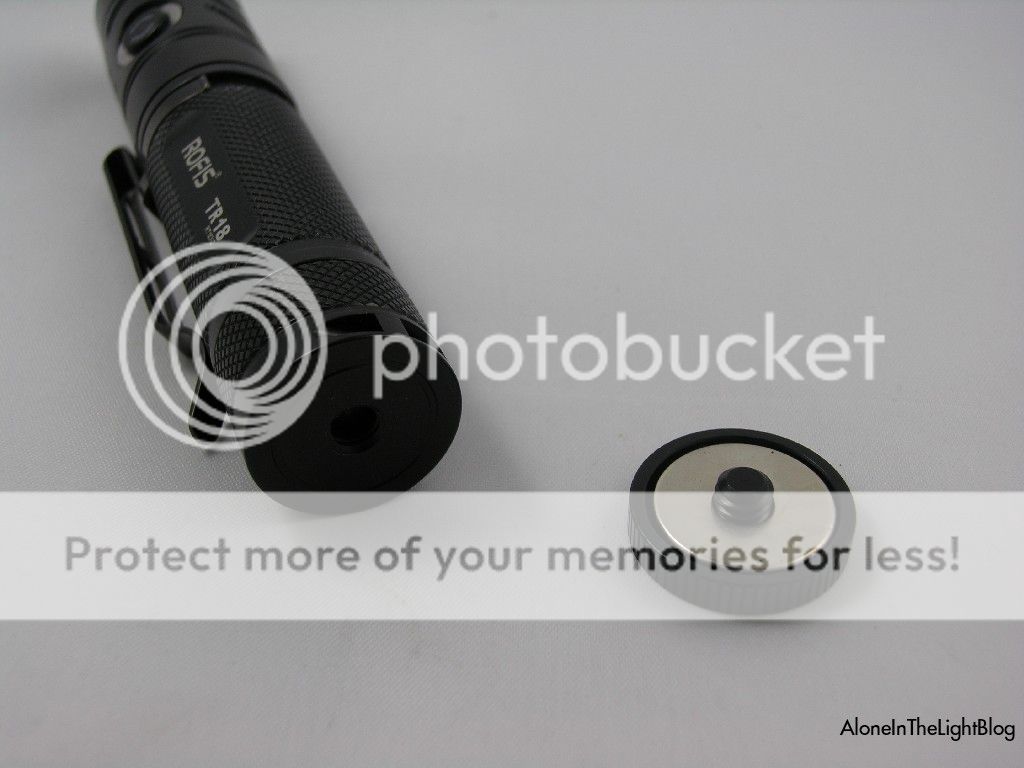
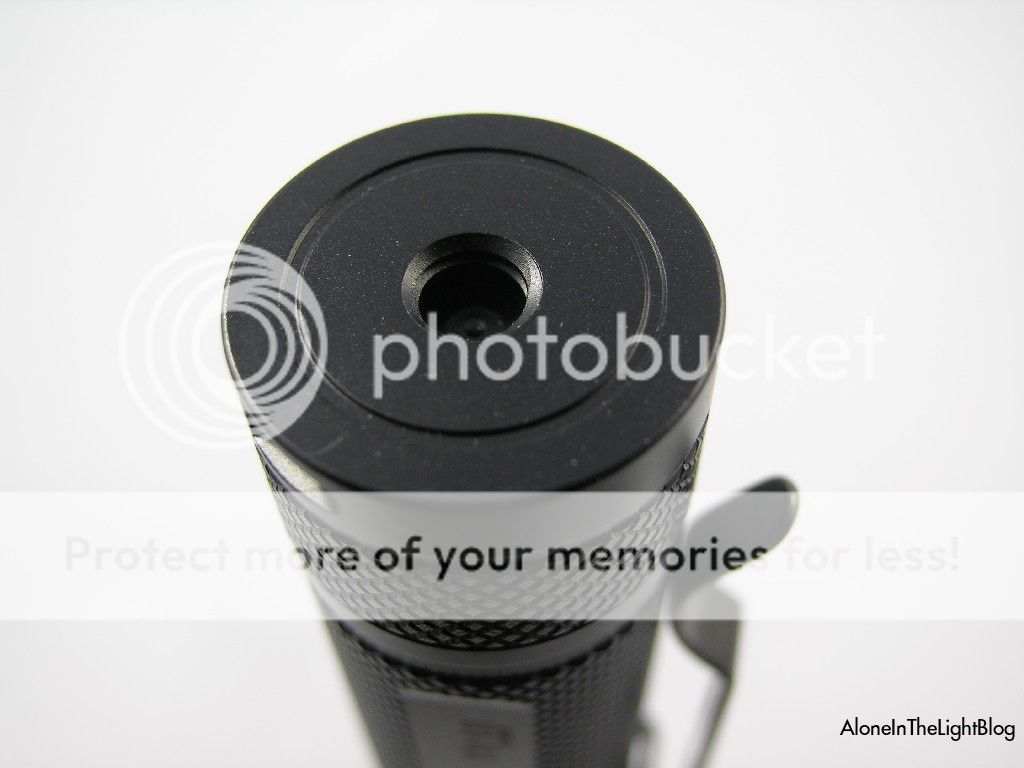
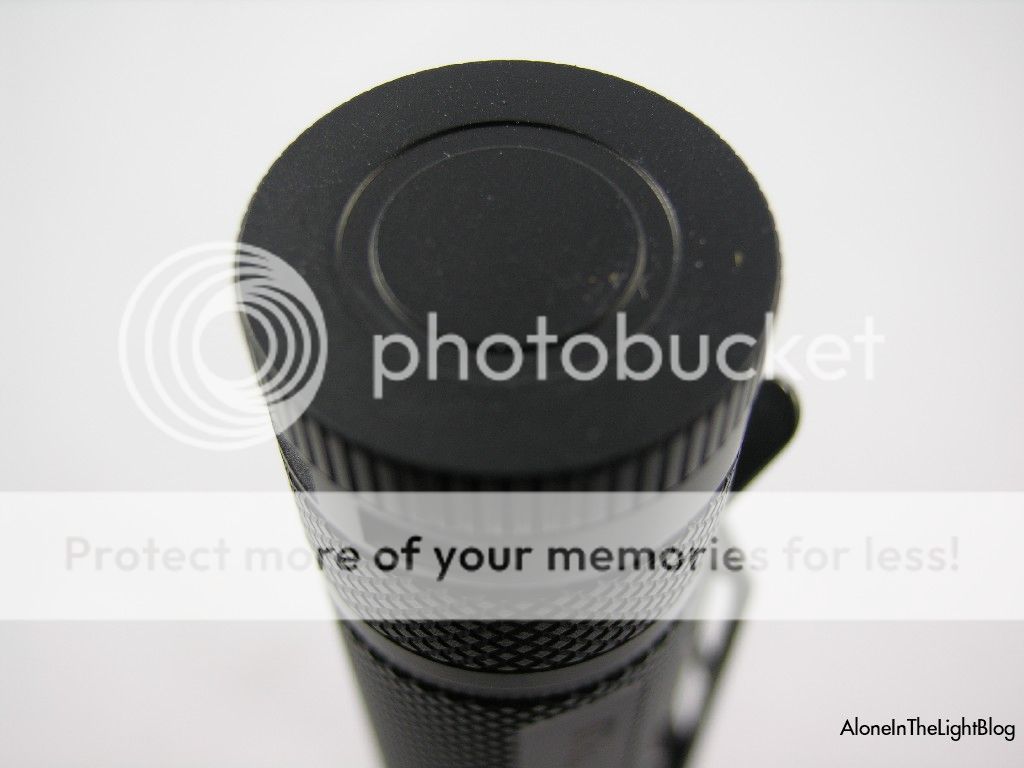
The threads are square cut and anodized on one side of the body (so physical lockout is possible). There was a tiny drop of what looks like thread locker on the connection between body and head, and I was able to unscrew the body with my hand with a little force.
Both connection point are golden springs.
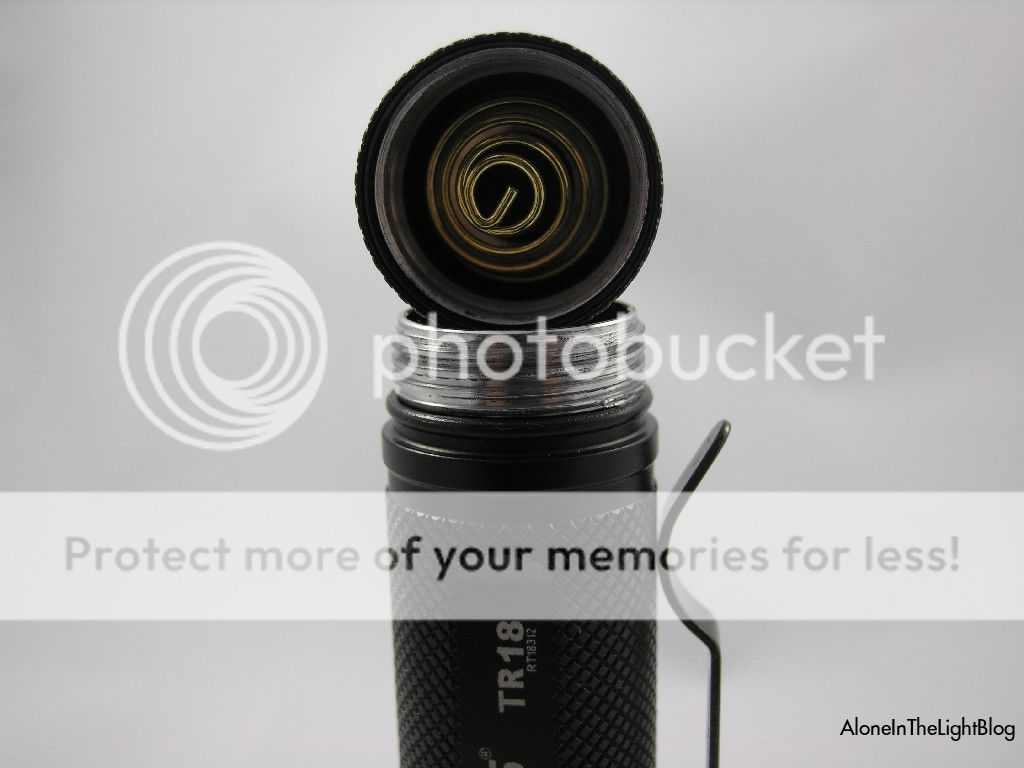
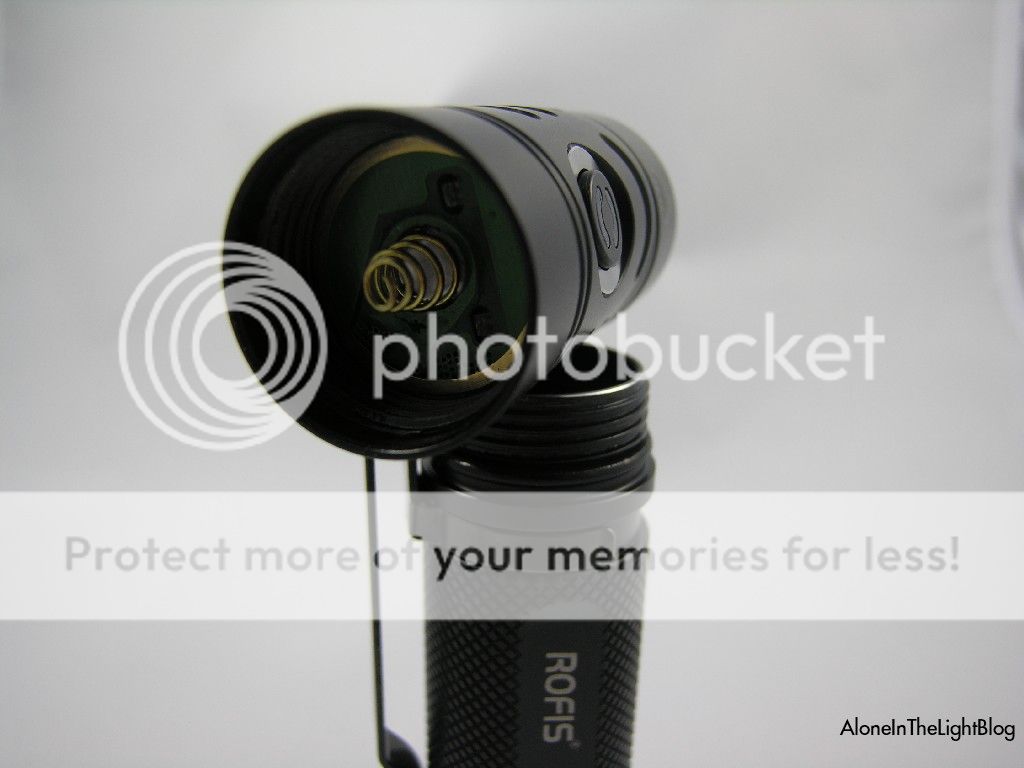
The TR18 with a LG MJ1 18650 cell
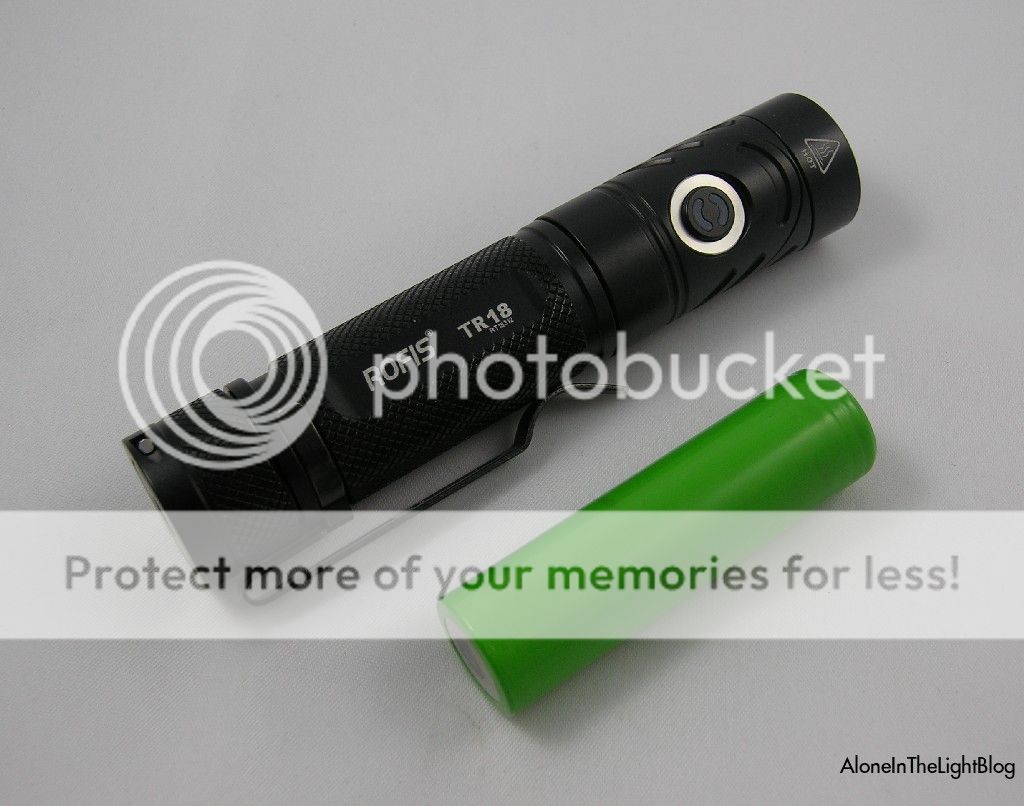
Side by side with the smaller brother Rofis TR10 (CR123 powered)
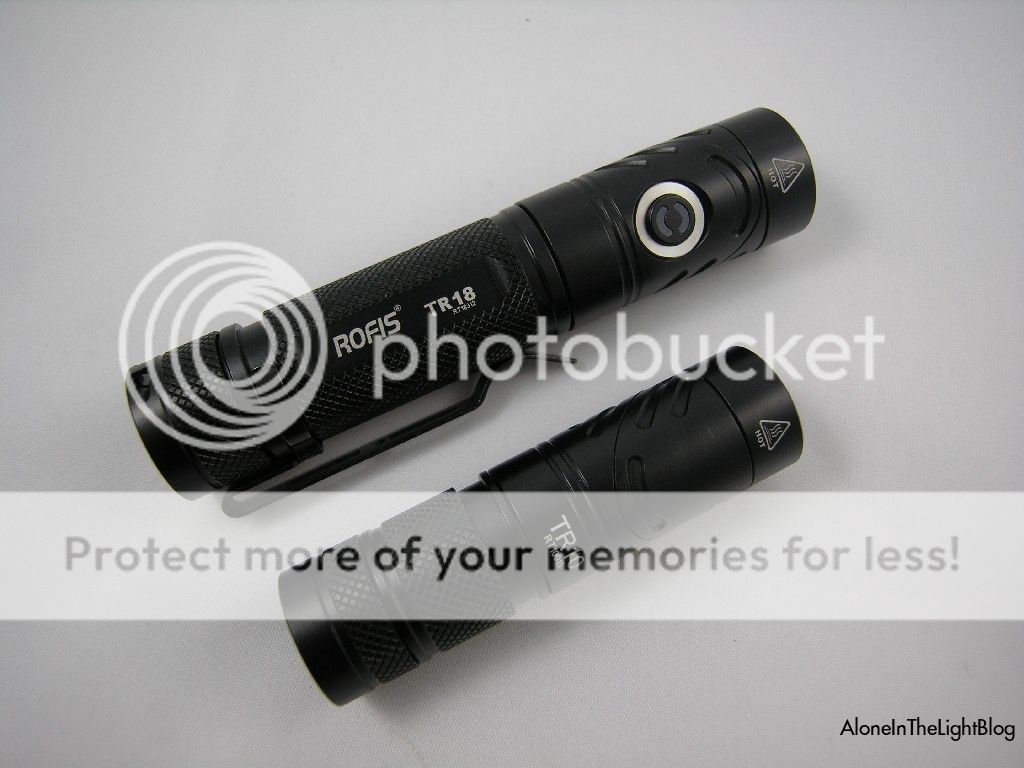
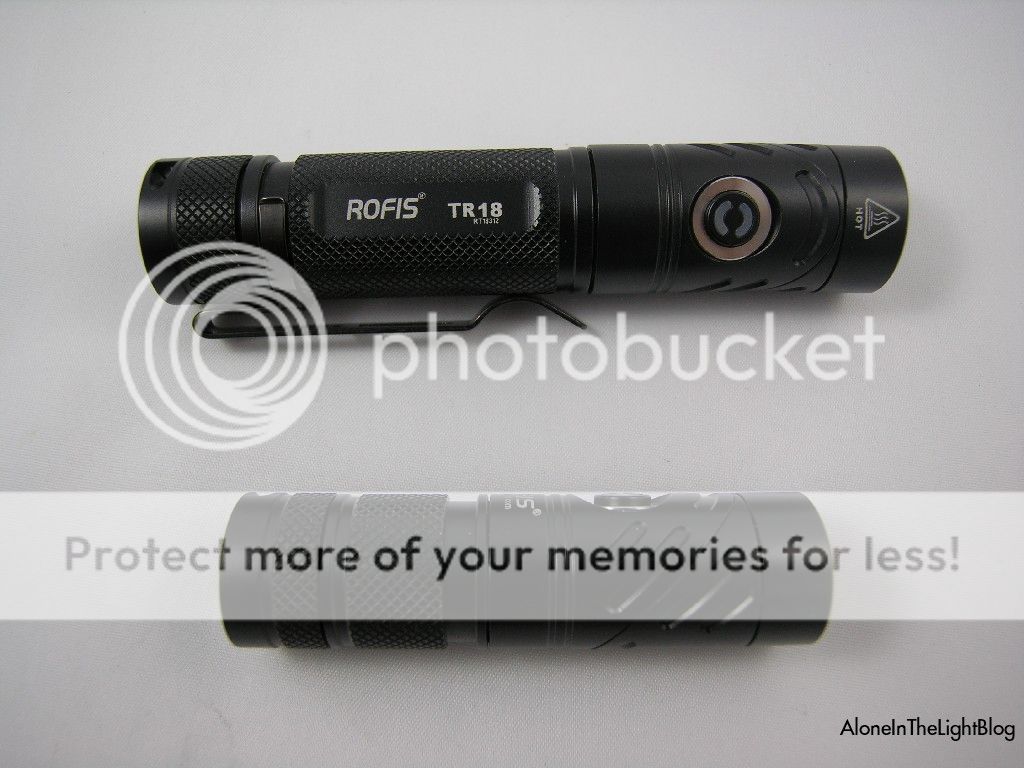
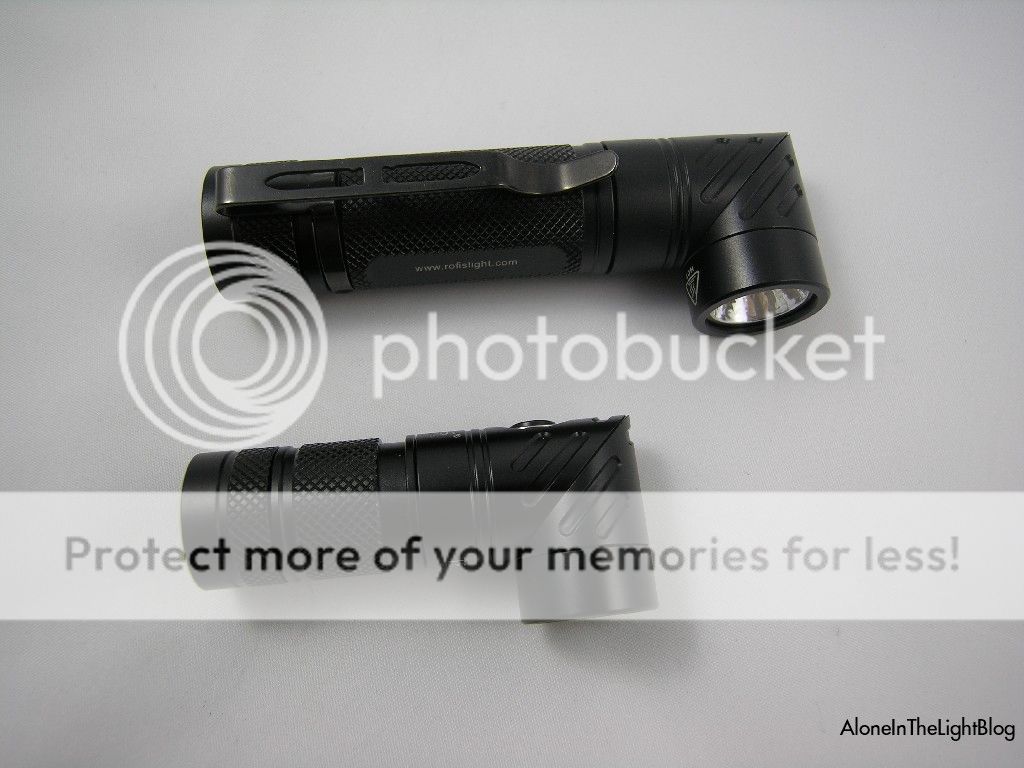
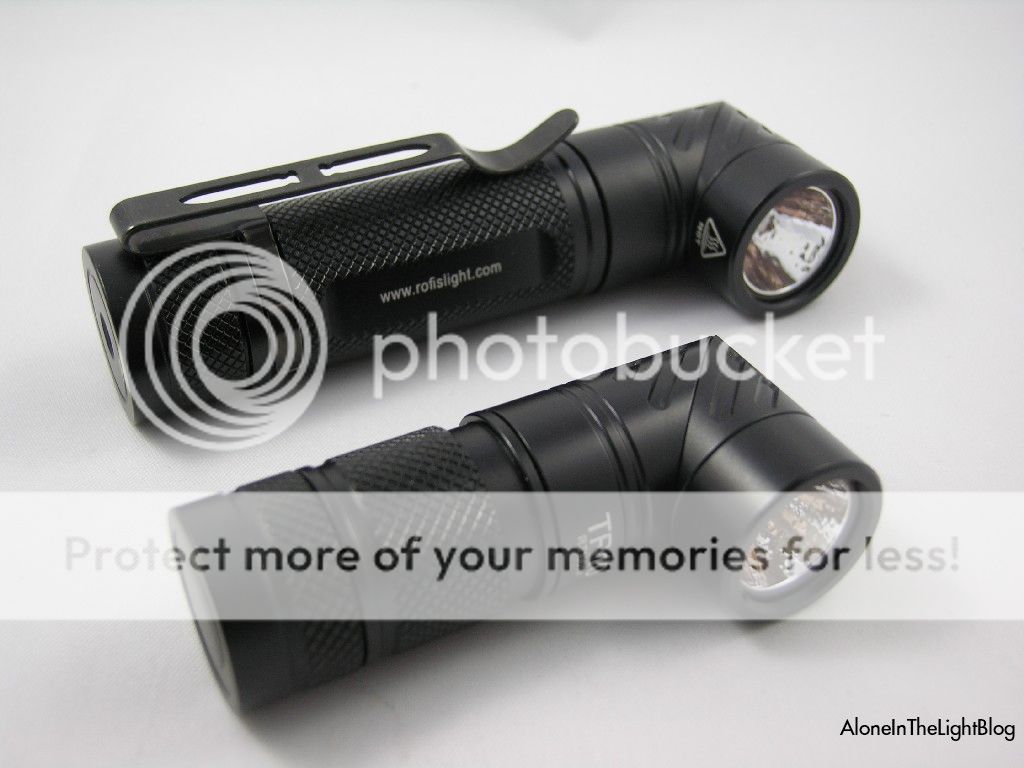
User interface
A single click of the switch turns the light on and off.
A long click from off turns the light on at the moon mode.
When the light is on, keep pressed the switch to cycle between the 4 modes (moon mode is accessible only from off). Keep pressing further and the light will turn off, while the LED under the switch will blink twice every three seconds as a locator.
A triple click activates the strobe, and keeping pressed the switch will cycle through strobe, SOS, beacon.
After turning the light on, the LED under the switch will indicate the level of charge (works only with 18650 cells):
- Green: >50%
- Red: <50%
- Red Blinking: <10%
From off, keep pressed the switch until the light turns on at moonlight and turns off to activate lockout mode. A long press will deactivate the lockout.
Output and runtime
Tested with a Rofis 3400 protected 18650 battery (note that this battery is not included in the package, I had it around).
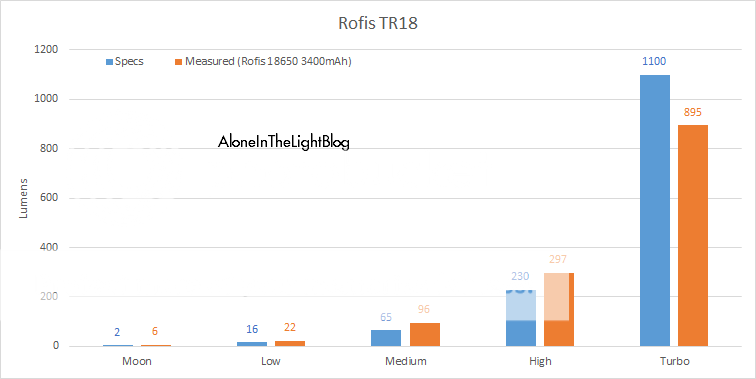
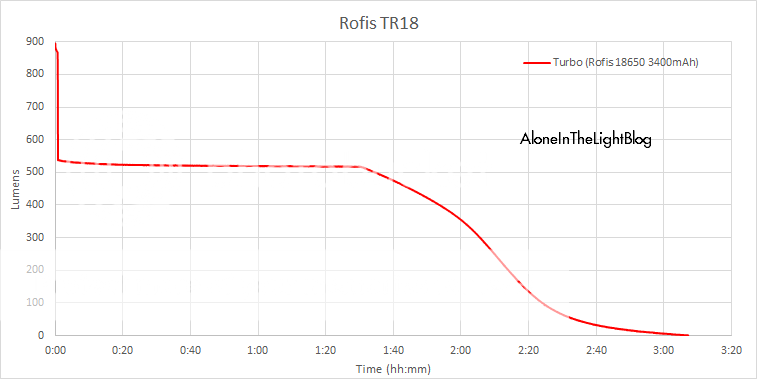
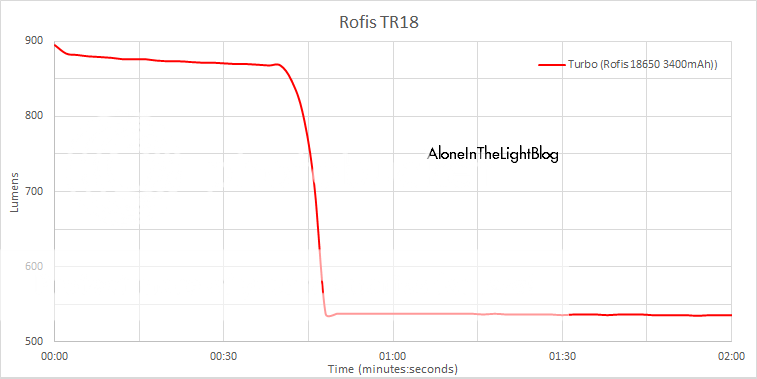
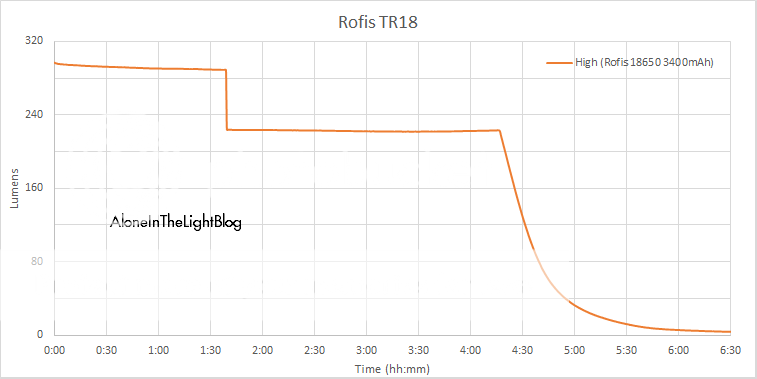
Beamshot
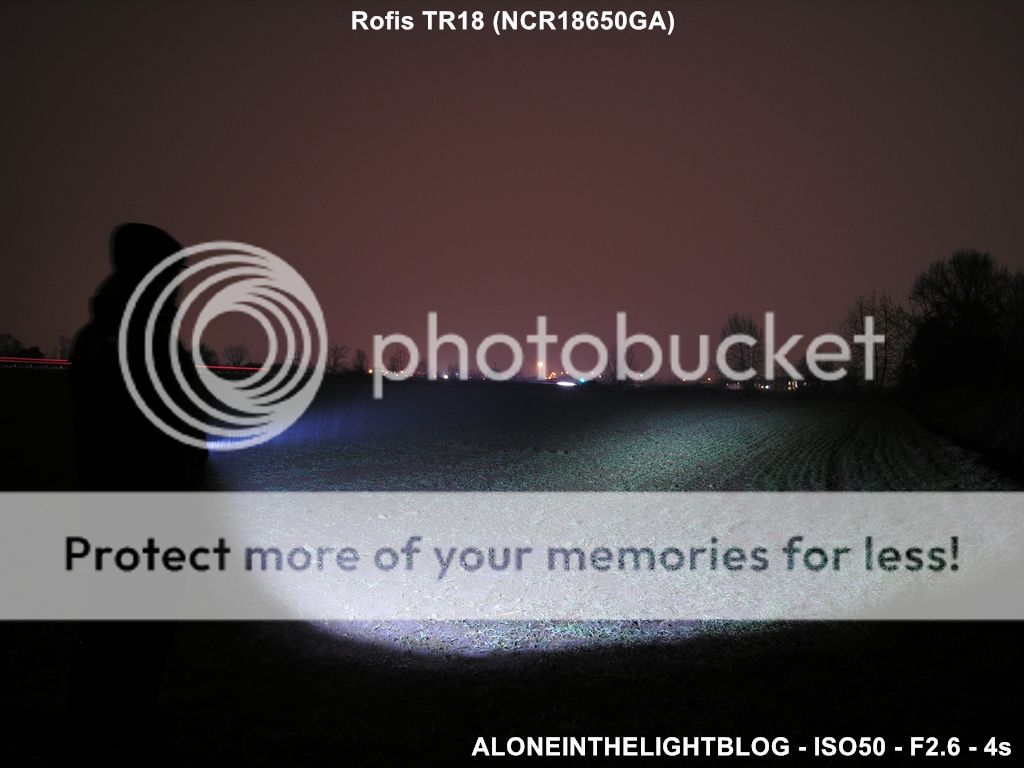
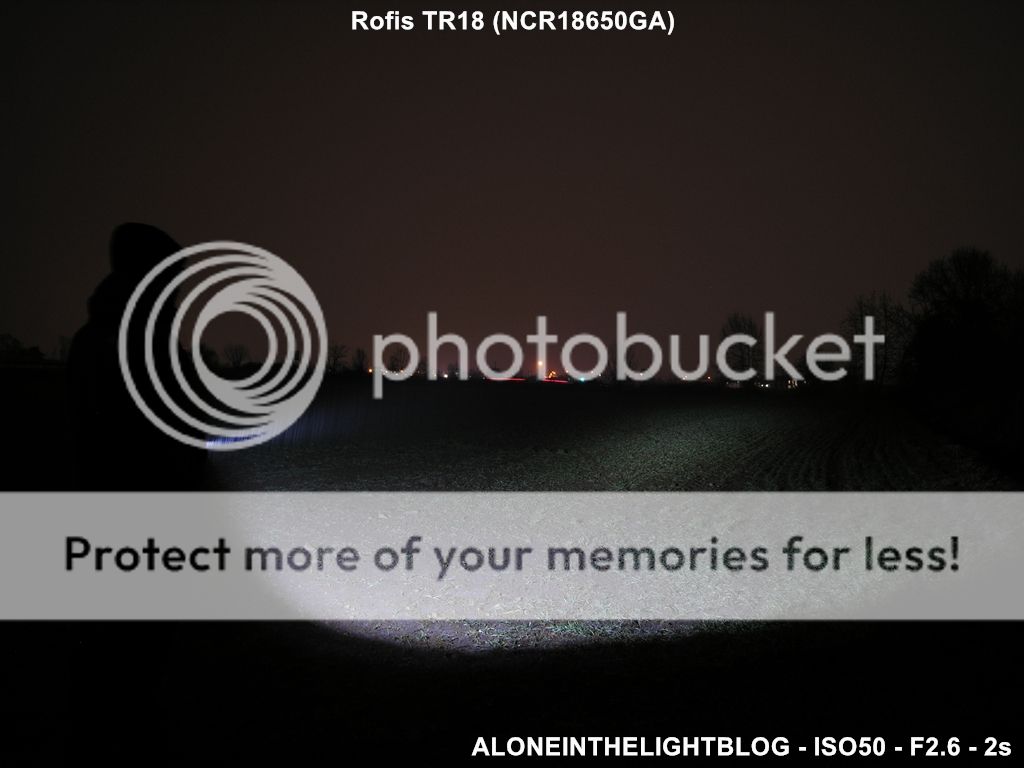
The TR18 has a lot of throw for its size, thanks to the XP-L Hi emitter.
My thoughts
The TR18 is well built and finished. I always like a sheath: it increases the chances of carrying the light (and to use it), and protects it.
The TR18 is the newest addition to the Rofis line of lights with rotating head. The rotating head increases the possible use of a flashlight. The magnet feature and tripod screw in the tailcap further increase the possible uses of the TR18, since you can now benefit of directional lighting using one or the other, plus you can rotate the head.
Compared to the TR20, the TR18 a smaller light and features a single switch, while the TR20 is bigger but with 2 switches and a micro USB charging port.
I like the direct access to the moonlight mode, but I'd also like a quick access to turbo mode. I also like the battery indicator.
The tested levels are well regulated, and the level spacing is fine on the low group of output, I'd like the 550 sub level of turbo mode to be accessible as a separate level. Why? Because you may be using the light at high level (300 lumens), and if you need more light, you are forced to go all the way up to 900 lumens.
As you saw in the beamshot, the spill is bright but not very close to the light. Since this light has in its own philosophy of use close range illumination, the spill should be wider, closer to your feet.
To obtain this, either the emitter could be changed (maybe an XM-L2 or XP-L), or the clear glass could be substituted by a frosted lens or some kind of flood optic (maybe Rofis could provide a frosted glass as an accessories, so you can swap between a clear and a frosted glass according to your needs).
I'd like to see this light come with a sheath and available in a NW tint.
Thanks to: AntoLed for the camera and the luxmeter.
The TR18 is another flashlight from Rofis that features a rotating head, transforming from a linear to a 90° flashlight. The TR18 is powered by an 18650 or 2 CR123 batteries.
The TR18 comes in this box


Inside the box: The TR18 with the clip, a sheath, lanyard, spare o-rings, magnetic tailcap accessory, manual, warranty card.


The TR18



Rofis rotating head system, on the TR18 works very smoothly and requires way less force than the one on the TR20





Inside the head there's a XP-L Hi emitter, in a light orange peeling reflector, under a glass with AR treatment.
There's an electronic switch at the head, accessible in both configurations


It has a LED underneath it


The clip is long and with good tension.

As in the TR20, the clip is not reversible, but the body is.

The tailcap is flat with tripod threads. In the accessories there is a magnetic tailcap attachment that can be connected screwing it in place



The threads are square cut and anodized on one side of the body (so physical lockout is possible). There was a tiny drop of what looks like thread locker on the connection between body and head, and I was able to unscrew the body with my hand with a little force.
Both connection point are golden springs.


The TR18 with a LG MJ1 18650 cell

Side by side with the smaller brother Rofis TR10 (CR123 powered)




User interface
A single click of the switch turns the light on and off.
A long click from off turns the light on at the moon mode.
When the light is on, keep pressed the switch to cycle between the 4 modes (moon mode is accessible only from off). Keep pressing further and the light will turn off, while the LED under the switch will blink twice every three seconds as a locator.
A triple click activates the strobe, and keeping pressed the switch will cycle through strobe, SOS, beacon.
After turning the light on, the LED under the switch will indicate the level of charge (works only with 18650 cells):
- Green: >50%
- Red: <50%
- Red Blinking: <10%
From off, keep pressed the switch until the light turns on at moonlight and turns off to activate lockout mode. A long press will deactivate the lockout.
Output and runtime
Tested with a Rofis 3400 protected 18650 battery (note that this battery is not included in the package, I had it around).




Beamshot


The TR18 has a lot of throw for its size, thanks to the XP-L Hi emitter.
My thoughts
The TR18 is well built and finished. I always like a sheath: it increases the chances of carrying the light (and to use it), and protects it.
The TR18 is the newest addition to the Rofis line of lights with rotating head. The rotating head increases the possible use of a flashlight. The magnet feature and tripod screw in the tailcap further increase the possible uses of the TR18, since you can now benefit of directional lighting using one or the other, plus you can rotate the head.
Compared to the TR20, the TR18 a smaller light and features a single switch, while the TR20 is bigger but with 2 switches and a micro USB charging port.
I like the direct access to the moonlight mode, but I'd also like a quick access to turbo mode. I also like the battery indicator.
The tested levels are well regulated, and the level spacing is fine on the low group of output, I'd like the 550 sub level of turbo mode to be accessible as a separate level. Why? Because you may be using the light at high level (300 lumens), and if you need more light, you are forced to go all the way up to 900 lumens.
As you saw in the beamshot, the spill is bright but not very close to the light. Since this light has in its own philosophy of use close range illumination, the spill should be wider, closer to your feet.
To obtain this, either the emitter could be changed (maybe an XM-L2 or XP-L), or the clear glass could be substituted by a frosted lens or some kind of flood optic (maybe Rofis could provide a frosted glass as an accessories, so you can swap between a clear and a frosted glass according to your needs).
I'd like to see this light come with a sheath and available in a NW tint.
Thanks to: AntoLed for the camera and the luxmeter.

